7 Day Andalusia Itinerary Without a Car – Spain Travel Guide

Are you planning a trip to Andalusia in Spain but are not sure how to organize it, what to see, which cities to visit, or how to get around without a car?
We’ve just returned from our one-week trip to Andalusia, where we visited Seville, Córdoba, and Ronda, with a short stop in Setenil de las Bodegas. We stayed in three different accommodations, tried different cuisines, and explored some amazing places and landmarks.
In this guide, I’ll take you through our trip day by day, the places we visited, how we got around without a car, where we stayed and ate, and how you can make the most of your own Andalusia adventure.
Before you travel:
👉Buy insurance – SafetyWing
👉Book your train tickets – Omio
👉Get an eSIM – Airalo
👉If you need to store your luggage, use Radical Storage
Day 1-3 in Seville
Seville, the capital of Andalusia and the warmest city in Europe, was the first stop on our trip. It’s a city rich in history, beautiful architecture, and a lively atmosphere.
Day 1-Arriving in Seville
We arrived in Seville late in the afternoon due to a delayed flight and some rain, so we couldn’t follow our full plan.
Originally, we wanted to explore the city centre, walk through the streets of Santa Cruz, have lunch, and see Plaza de España at sunset. The plaza is just a 15-minute walk from the city centre, so it’s easy to reach if you have more time or better weather.
Day 2 in Seville – Triana and Seville Cathedral
On our second day, Seville was hit by heavy rain, the kind they said hadn’t happened in years. Still, we didn’t let it stop us from exploring.
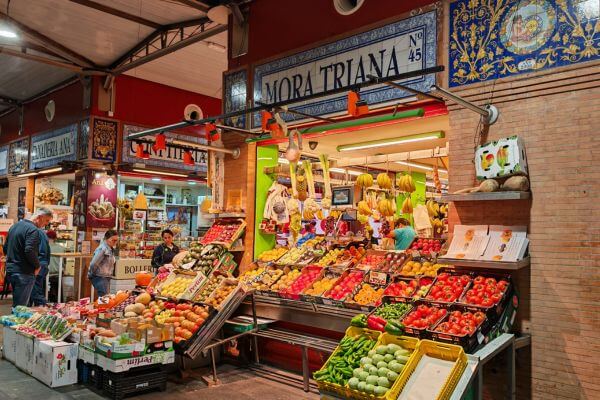
Instead of walking, we took a bus across the river to visit Mercado de Triana, an indoor market where you can find Spanish tapas, fruits, vegetables, coffee, cakes, and souvenirs. It’s a great spot to experience local life.
From there, walk across Triana Bridge (Puente de Isabel II), Seville’s most famous bridge, connecting the city centre with the lively Triana neighbourhood. It’s the oldest iron bridge in Spain and offers beautiful views of the Guadalquivir River (ours were mostly umbrellas and raindrops!).
Continue along the river promenade until you reach Torre del Oro (Tower of Gold), a historic watchtower that once protected Seville’s port. You can climb to the top for a great view of the city.
For lunch, we stopped at Señora Pan, a 100% gluten-free restaurant just 5 minutes from Seville Cathedral. They serve both Spanish and international dishes. The customer service was excellent, and the atmosphere was warm and cozy.
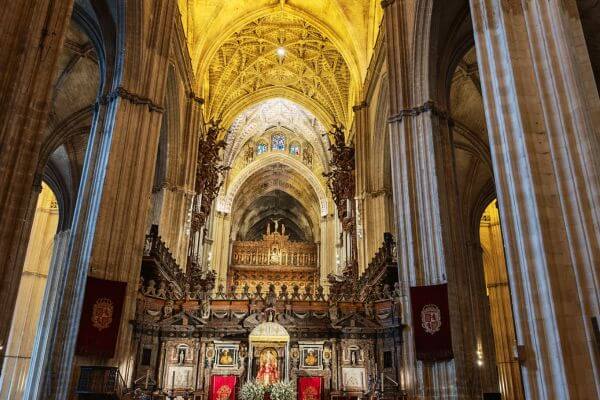
Our next stop was the Seville Cathedral, a UNESCO World Heritage Site officially known as the Cathedral of Saint Mary of the See. It was built on the site of a grand mosque from the 12th century. After the Christian reconquest, the mosque was converted into a cathedral.
The cathedral is huge, and the views from the Giralda Tower are amazing. We booked the tickets in advance as it is a very popular landmark.
Useful info:
- Tickets: €13 per adult (children under 13 enter free with an adult)
- Audio guide: €5
- Booking: Official Cathedral Website or GetYourGuide (book at least one week in advance)
- Opening hours: Monday–Saturday: 11:00 AM–6:00 PM
Sundays: 2:30 PM–7:00 PM
Day 3 in Seville – Plaza de España and Alcázar
The third day was our favourite, finally, no rain! Start early and visit Plaza de España, for me, the most beautiful spot in Seville.
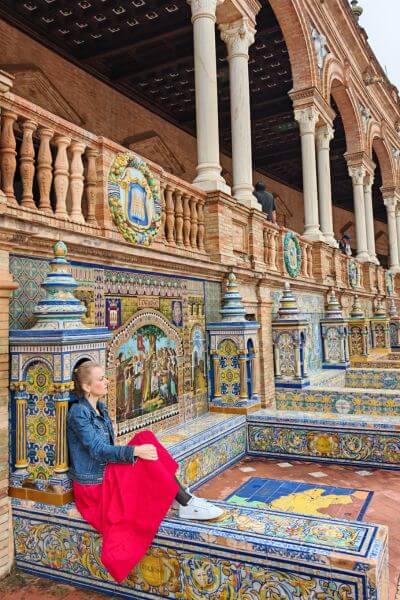
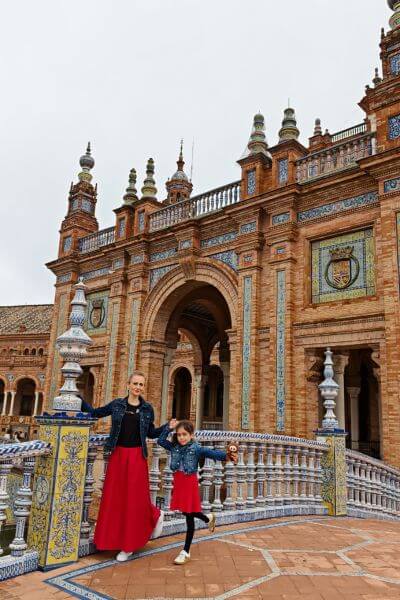
Built for the 1929 Ibero-American Exposition, it has a semi-circular shape and a mix of Renaissance, Baroque, and Neo-Mudejar styles.
There’s a canal with four bridges, and you can normally rent a boat, though during our visit, there was no water. The plaza is so beautiful, with reddish colors and colorful ceramic tiles, with a fountain in the middle.
It is often filled with music, flamenco dancers, and people taking photos. It’s open and free to visit. I recommend going early in the morning before it gets crowded.
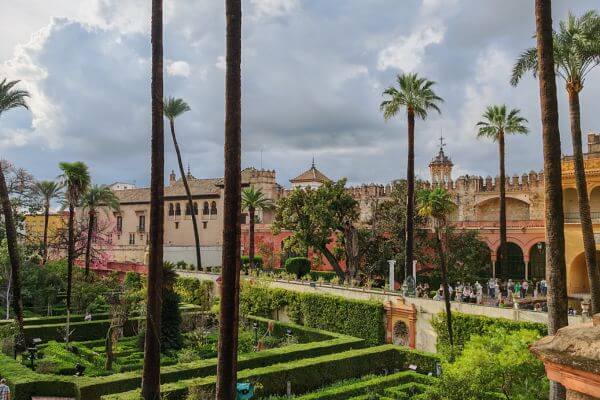
After lunch (we went back to Señora Pan restaurant, our daughter’s favorite), we visited the Royal Alcázar of Seville, another UNESCO World Heritage Site.
It’s one of the oldest royal palaces still in use today, known for its beautiful mix of Moorish and Christian design, colorful tiles, gardens, and courtyards. It was even used as a filming location for Game of Thrones.
The Alcázar is large, so plan to spend a few hours exploring. As this is the most popular landmark, book your ticket in advance.
Useful info:
- Tickets: €15.50 (general admission)
- Upper Royal Room: €5.50 extra
- Children under 13: free with an adult
- Opening hours:
- October–March: 9:30 AM–5:00 PM
- April–September: 9:30 AM–7:00 PM
- Book via the official website or GetYourGuide (recommended in advance)
TIP: Bring your passport with you, as they randomly check passports at the entrance
How to reach Seville and get around
- By plane – Fly into Seville International Airport. From there, you can take a taxi, private transfer, or the EA bus to the city centre. The bus costs €6 per person one way and runs from 4:30 AM to 1:00 AM. You’ll find it right outside the airport.
- By train – Seville’s main station, Santa Justa, is well connected with cities like Córdoba, Cádiz, and Granada.
We mostly walked everywhere as most attractions are within 15–25 minutes. If you prefer not to walk, you can use the bus, tram, or metro. We only used the bus once when it was raining.
Where to stay in Seville
The best option is to stay close to the city centre so you can easily walk to the main attractions.
We stayed in two different apartments:
1. Patio Rialto Apartment – near Santa Justa train station.
Quiet area, about a 15-minute walk to Seville Cathedral. The inner courtyard is in lovely Spanish architecture.
The apartment was spotless, with two bedrooms, a kitchen, a bathroom, and a living room. We enjoyed our stay here.
➡️Check the Patio Rialto Apartment here
2. RentalSevilla Alameda – near Alameda de Hércules.
In a lively area full of restaurants, about a 15-minute walk to the centre and 9 minutes to Metropol Parasol. It’s a modern two-floor apartment with two bedrooms, two bathrooms, a kitchen, and a large living room.
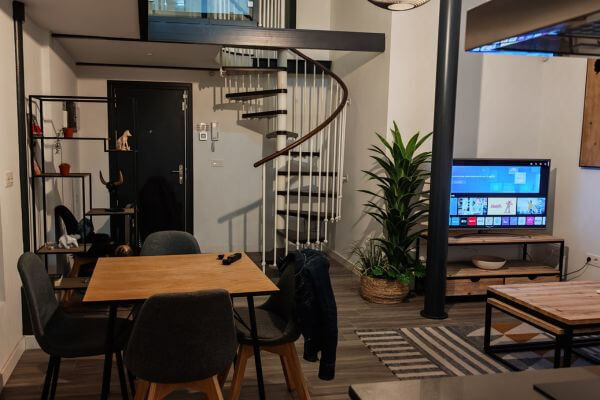
Overall, our stay was enjoyable, but there were a couple of downsides. When we arrived, there was a mix-up with the door code, though it was quickly resolved.
Another issue occurred when a drop of rusty water fell from the ceiling onto my white jumper, leaving a stain that couldn’t be removed.
➡️Book the stay in RentalSevilla Alameda here
➡️Click here for more options for hotels and apartments in Seville
Where to eat in Seville
Seville has plenty of restaurants offering both Spanish and international cuisine. If you want to try traditional food, look for tapas, small plates of croquettes, cheeses, oxtail stew, meat, seafood, and more.
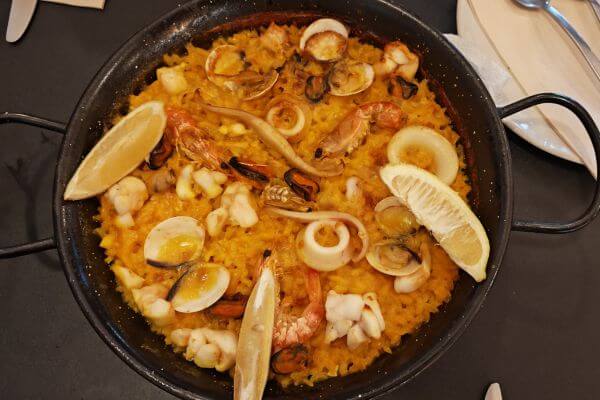
If you follow a gluten-free diet like we do, you’ll find many options. Even if a restaurant isn’t fully gluten-free, many offer gluten-free meals; just ask.
We ate at:
Senora Pan – 100% gluten-free restaurant, Calle Zaragoza, 64
Chök bakery and sweet shop – two city-centre locations (Plaza Jesús de la Pasión 8 and Sagasta 20)
Karpanta restaurant – lively place with delicious food, big portions, amazing customer service, and gluten-free options. Located on Alameda de Hércules, 7
Amorino Gelato – famous for its rose-shaped ice cream (gluten-free cones available), several locations, including Av. de la Constitución 30 opposite the Cathedral
Maria Limones Placentines – ice cream shop on C. de Placentines 33, Casco Antiguo
You will also find gluten-free products in grocery stores like Carrefour and Mercadona.
Day 4-5 in Córdoba
Córdoba is a small, cozy historical city with narrow streets you’ll love to wander through and impressive architecture around every corner.
Day 4 in Córdoba – La Mezquita
On the fourth day, we travelled from Seville to Córdoba. No car is needed as the train connection between the two cities is excellent.
We booked our tickets in advance through Omio, which made it easy to compare times and prices. We bought return tickets, and the journey took about 1.5 hours.
We arrived before lunchtime and stored our luggage in the city centre since check-in wasn’t available yet.
We used Radical Storage, which has several drop-off points around the city. You simply book online, show the confirmation in the shop, and you’re free to explore without your bags.
As we walked through Córdoba, we instantly fell in love with it. It’s small but lively and full of character.
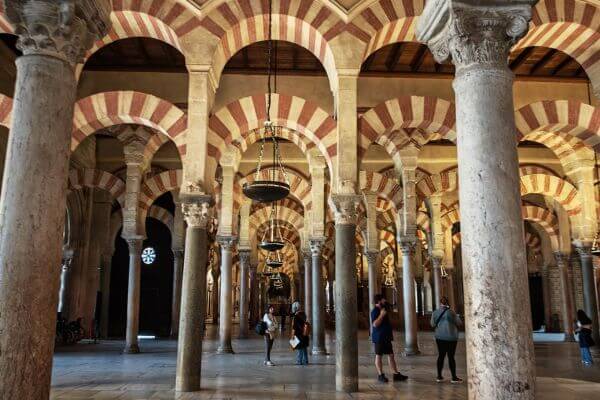
We had lunch at Ginos Restaurant, checked into our apartment (right in the city centre), and headed to see La Mezquita (Mosque–Cathedral), for which we had booked tickets in advance.
It’s one of Spain’s most unique landmarks. Originally built as a mosque and later converted into a cathedral. The mix of Islamic and Christian design is incredible, and the interior has a special, mystical atmosphere.
Useful info:
- Tickets: €13 (general admission)
- Children under 10: free with an adult
- Children from 10 to 14: €7
- Opening hours: 8:30 am to 6 pm (may vary during events or worship times)
- Book via the official website or GetYourGuide (recommended in advance)
After visiting the Mezquita, we wandered through the narrow streets and picked up some souvenirs. In the evening, we went to a Halloween show with our daughter.
If you have more time, you can:
- Go shopping in the city centre or at La Sierra Shopping Mall
- Visit the Roman Temple (free to enter). We didn’t have time, but it’s another interesting spot in Córdoba
Day 5 in Córdoba – Roman Bridge
In the morning, we walked through the old streets to reach the Roman Bridge, one of Córdoba’s most famous landmarks. We later realized it’s located just behind the Mezquita.
The bridge crosses the Guadalquivir River and offers beautiful views of the old town and the Mosque–Cathedral. We enjoyed the sunny weather, took photos, and admired the views.
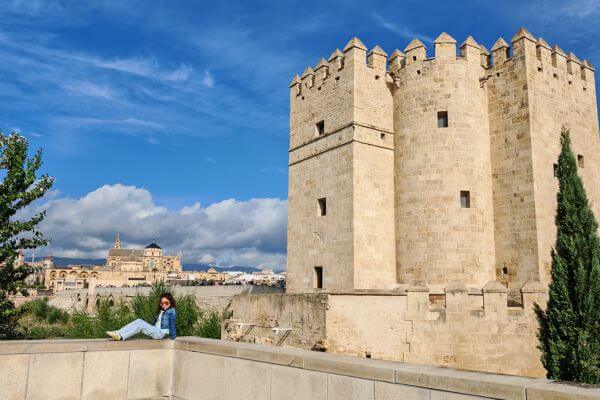
On the other side of the bridge is the Calahorra Tower, which you can climb for a view of the city (note: children under 8 are not allowed).
We then stopped by the Synagogue, but it’s just a small one-room site, so in our opinion, not really worth the time. After checking out of our apartment, we had lunch at LaMundi Restaurant.
Since we already had our luggage with us, we couldn’t explore more. We would’ve loved to see the Roman Temple or walk through the city again. Instead, we relaxed in a nearby park before catching our train back to Seville.
If you have extra time, don’t miss The Alcázar of the Christian Kings, another important landmark. You can buy tickets at the gate or online (it’s currently under some reconstruction).
How to reach Córdoba and get around
- By plane – Fly into Córdoba International Airport, then take a taxi, private transfer, or bus to the city centre.
- By train – Córdoba’s train station, Julio Anguita, is well connected with cities like Seville, Cádiz, and Málaga.
- Getting around: Córdoba is very walkable, most landmarks are close to each other.
Where to stay in Córdoba
Stay in the city centre so you can easily walk to all the main attractions.
We stayed at Torre de Campanas, a one-bedroom apartment with a kitchen, living room (with a sofa bed), and dining area. The apartment had a nice view of a nearby church, and the owners were very kind and helpful.
It did get a bit noisy on Friday night since it’s on the main street, but the location made up for it.
➡️Book your stay at Torre de Campanas here
➡️Click here for more options for hotels and apartments in Córdoba
Where to eat in Córdoba
Just like in Seville, you’ll find many restaurants offering both traditional and international cuisine. There are also plenty of places with gluten-free options, some are 100% gluten-free, others offer gluten-free dishes.
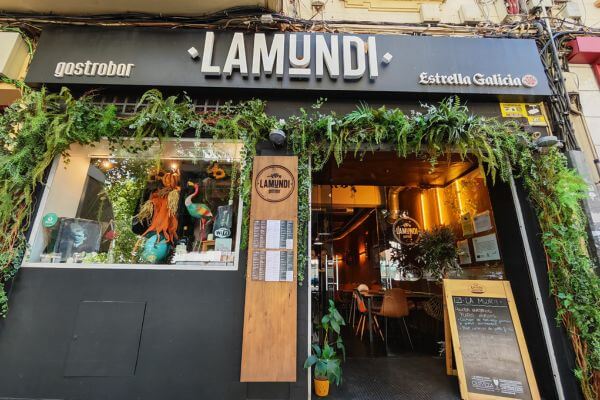
We ate at:
Ginos – Italian restaurant in the city centre with gluten-free pizza and pasta options. Address: Calle Ángel Saavedra 1
LaMundi – Located on a busy street in the city centre with outdoor seating. Offers local and international cuisine with gluten-free options.
You can also find gluten-free products in grocery stores like Carrefour.
Day 6 in Seville – Football stadium and Las Setas
On the sixth day, we decided to take it a bit easy. My husband, who is a football fan, went to visit Seville’s Ramón Sánchez Pizjuán football stadium. He booked a tour 2 days in advance.
The stadium was just a few minutes away from our accommodation by bus.
➡️Book your tour for Seville’s Ramón Sánchez Pizjuán football stadium here
When he returned, we went for lunch at a restaurant next to our flat. Karpanta restaurant offers different kinds of dishes and also has a gluten-free menu. It was always busy, so it seems to be a popular place to eat.
After lunch, we went to buy some souvenirs. I recommend a shop called Artesanías Medina. We found their stores in Seville, Córdoba, and Ronda. They have the lowest prices and really beautiful souvenirs to choose from.
Later in the afternoon, we went to see the Metropol Parasol (Las Setas), also known as “the mushroom.” It’s one of Seville’s most modern landmarks, a huge wooden structure with great views from the top, plus a light and immersive show at night.
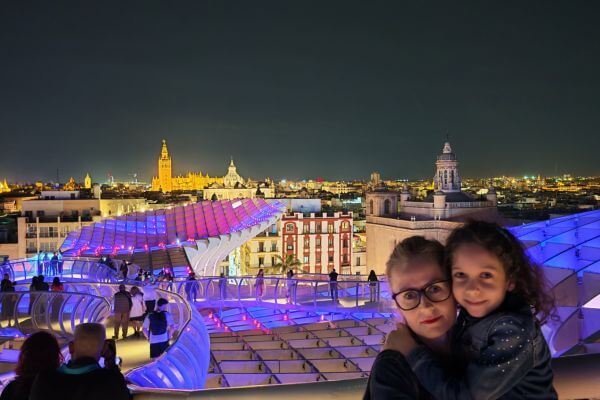
We didn’t buy tickets in advance because we weren’t sure about our timing. When we arrived, sunset tickets were already sold out, so we booked the next available time at 7:45 p.m. and came back later.
I highly recommend visiting the Metropol Parasol. The view from the top is amazing, and the lights and music make it even more special.
But the best part was the immersive experience. We sat in a small theater where a movie about Seville was playing. It felt like flying on a drone over the city, seeing all the landmarks from above.
There was also a woman dancing flamenco, men singing, and even a running horse. It all felt so real, like being part of the movie. A really awesome experience.
Useful info:
- Tickets: €16 (general admission)
- Children up to 5 years old: Free
- Family tickets:
- Family Pack 2 (1 adult + 1 child): €27
- Family Pack 3 (2 adults + 1 child): €39
- Family Pack 4 (2 adults + 2 children): €50
- Family Pack 5 (2 adults + 3 children): €60
- Tip: Book tickets in advance if you want to visit during sunset.
You can book tickets through the official website (family ticket options available) or GetYourGuide (recommended for regular admission).
Day 7 – A day trip to Ronda
On our last day, we took a full-day tour to Ronda with a short stop in Setenil de las Bodegas. We really wanted to see Ronda, but going by train would have meant staying overnight, and we didn’t have that much time.
So, we found this one-day tour through GetYourGuide. It was hassle-free, well-organized, and gave us enough free time to explore on our own. Plus, it was cheaper, €45 per person.

The meeting point was in Seville, where we got on the bus for a 2.5-hour ride to Setenil. We had about 70 minutes there to walk around and take photos, not much, but enough to see this small, unique village.
After that, it was another 20 minutes to Ronda, where we had four hours to spend. If you choose the guided option, the guide takes you around for 1.5 hours, and then you have the rest of the time free.
If you don’t book the guided option, you have the full four hours on your own. We explored on our own.
First, we stopped for lunch at Pizzeria Da Vinci, an Italian restaurant we found online with gluten-free options. The pizzas were huge and delicious, and the restaurant had a nice, clean interior.
After lunch, we walked through the city to reach the most famous landmark, the Puente Nuevo Bridge.
The Puente Nuevo, which means “New Bridge,” is an impressive 18th-century bridge connecting the old and new parts of Ronda. It rises about 120 meters (390 feet) above the Guadalquivir River, stretching across the deep El Tajo Gorge.

We took plenty of photos and videos while walking across the bridge and went down one side for a different view. Unfortunately, we didn’t have time to go down the other side, where there’s also a small waterfall.
Before heading back to Seville, we grabbed a coffee and took some photos in front of Plaza de Toros.
If you only have one day, I highly recommend taking this tour. It was relaxing and well-paced. Our guide, Vanessa, was so positive, friendly, and cheerful. She really made the trip enjoyable.
We just wished we had one more hour to explore Ronda, but then we would have arrived back in Seville quite late. I believe the earlier return is for safety reasons, as it’s better not to drive those mountain roads at night.
➡️Book the one-day tour from Seville to Ronda here
We had a truly amazing week in Andalusia. I’m really glad we chose these cities. Everything worked out so well, even with the rain during the first day.
We managed to see them all without a car, and it was easier than we expected. Each place had its own character, and even our 6-year-old girl truly enjoyed each place.
I’ll be sharing a video from this trip soon on my YouTube channel, so make sure to subscribe if you’d like to see the highlights and get a better feel for what Andalusia is really like.
You may also like:
10 Best Things To Do On The Amalfi Coast, Italy – Travel Guide
Siwa Oasis Travel Guide For First-Time Visitors
Top 9 Least Crowded Beaches In Europe